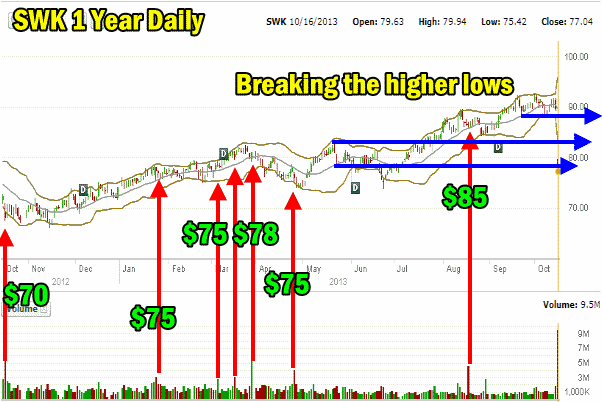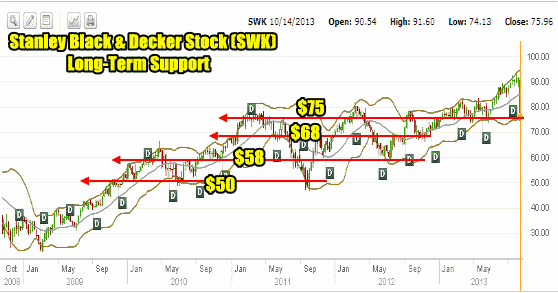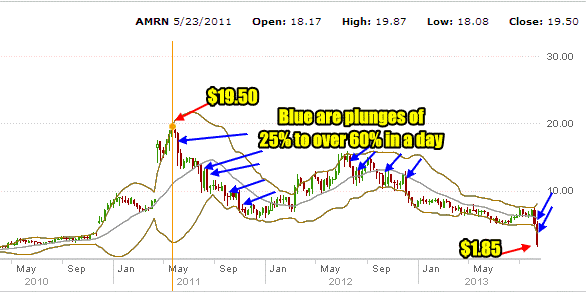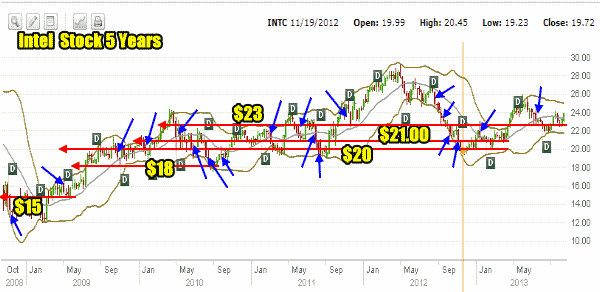Stanley Black & Decker Stock (SWK) plunge appears to be winding down for now. I would expect the stock to push higher from here and then perhaps languish or move back to retest how much or how strong support is at the $74 – $75 level. Stanley Black & Decker Stock (SWK) represents a very good company. Book value is $41.68, cash flow is $6.03 a share and revenue was over $10 billion to date. The plunge provided some excellent Put Selling opportunities and still does and will for some time as the stock attempts a recovery of sorts.
Stanley Black & Decker Stock (SWK) Annual Dividend
The annual dividend at present stands at $2.00 for a return of 2.59 percent. This is slightly above the average for this sector. Debt to capital is respectable at 41%. Stanley Black & Decker Stock (SWK) has seen its dividend almost double in the last 3 years.
Now that the plunge is three trading days old inclusive of today, let’s see what the recovery looks like and how the Put Selling strategy I am using will continue to work or be adjusted.
Stanley Black & Decker Stock (SWK) Uptrend Ended
In my chart from earlier this week when Stanley Black & Decker Stock (SWK) collapsed I showed the various support levels as the stock climbed. It has been on a terrific rise all year. You can see in the chart below that the stock has broken the uptrend. However that said, the stock did manage to hold the $75 level which has strong support from earlier this year. That’s actually not too bad. After $75, the stock would have to fall back to $70 to reach another strong support level. The fact that Stanley Black & Decker Stock (SWK) bounced at the $75 valuation level is quite good for the stock and perhaps we will see it set up a new trading range around that support level.

Stanley Black & Decker Stock (SWK) is widely held. This adds a lot of support to the stock as well. The volume was huge during the sell-off which tells us that while many investors were dumping their shares other investors were busy picking up those shares. Often when a stock like Stanley Black & Decker Stock (SWK) falls hard, it is the institutional investors (pensions etc) that will pick up more shares. They are often in a stock much lower and have been accumulating shares for many years. They often look upon a drop such as we saw in the stock on Oct 16 and 17 as an opportunity and they are basically averaging up. These larger investors hold this type of stock for its dividend growth which is a strong plus for Stanley Black & Decker Stock (SWK).
Stanley Black & Decker Stock (SWK) Put Selling Against Long-term Support
When Put Selling a stock you want to look back at the history of that stock. While history definitely changes over time and revenue changes as well as earnings and growth, the history still has significant value for investing purposes. For example for Stanley Black & Decker Stock (SWK) its history shows us 4 very solid support levels. This makes my job as an investor a lot easier. The chart below shows that at $75 it was worth selling puts and picking up shares on the plunge. Think back to when the stock was over $80 and $90. Many investors who wrote me after the collapse were busy selling puts and buying shares at those levels because the stock looked to be in a very solid uptrend.
But when you look at the chart below you can see that there is no support built into the stock at those levels. It would take many months of the stocks pulling back and moving up several times to build that kind of support. But the $75 level had support from earlier this year and going back to 2012 and 2011. This is why on a day like Oct 17 when investors are dumping their shares in fear, other investors who have looked at charts such as the one below, know that they should pick up shares as cheaply as they can get them on a day like Oct 16 and 17.
Investors often ask me how do I know my entry points. It is because of chart studying. Even without adding in volume you can see in the chart below how often the stock hit a specific price and then pushed back up higher. Those are the support points in the stock.
For a stock like Stanley Black & Decker Stock (SWK) investors are of two sets. There are large institutional investors who have picked up this stock at various strikes over the past 5 years or longer. They would see a day such as Oct 16 and 17 and buy a few more shares to average up. They are interested in strong stocks that pay healthy growing dividends and can continue to support those dividends. This company can do that. When that ends, these investors will move out and into a different stock.
The second set of investors are traders. I am among that group. I look for opportunities such as Oct 16 and 17 to pick up shares just below support and then unload them on a bounce back up. I also use that opportunity to sell puts at and below support.

Why Big Cap Stocks Are Easy To Invest In
It is a very easy trade to pick up shares on a steep decline in a stock like Stanley Black & Decker Stock (SWK) because of the strength of the stock and the underlying company themselves. While a junior stock can indeed shoot through the roof and I get a so-called “double-banger” or even a “triple-banger”, junior stocks are filled with difficulties. When their earnings fail these stocks can collapse by 25% or more in a single day.
Months ago on my Yahoo forum (which is free to join) some investors had discussed the merits of trading within a junior stock AMRN. The debate became heated but the merit of it was worth noting. This was a company with the “possibility” of earnings. It had 111 employees and revenue of 7.8 million and growing. Today the company has earnings of negative 92 cents a share and obviously is in deep trouble. Those who got in early and got out near the tops over the past two years probably did well. The majority of investors though did not. Every single blue arrow on the chart marks a plunge in this stock of no less than 25%. Just this week along the stock plunged over 61% on Oct 17. I have received a number of emails from investors who sold puts wondering what they can do to repair their trades. These types of trades are not repairable. This type of stock destroys portfolios and there are many of them. The investing world is filled with these kinds of stocks and indeed they are in the majority.

Strength Is In The Big Cap Stocks
Instead when a stock like Stanley Black & Decker Stock (SWK) plunges I know the strength behind the company and the support levels it has. This makes Put Selling easy and profitable. That said if I was wrong and the stock collapsed further, I also know how to repair the trade and where to commence new ones. If Stanley Black & Decker Stock (SWK) fell to $75, then $68, then $58 and finally $50, I would know at each of those levels what I should do. There is no reason to flee from a stock like Stanley Black & Decker Stock (SWK). Therefore rather than have my portfolio take losses I can continue to profit even though the stock may be in a decline.
Intel Stock
Another good example is Intel Stock. This stock has disappointed a lot of investors but it is their approach that is wrong not the stock itself. For an investor such as myself looking back 5 years I can easily see the support levels within the stock. The chart below shows that like every stock, Intel Stock has had its share of plunges too. rarely are those plunges more than 5% but for a stock as big as Intel, 5% is a big plunge. The blue arrows below show plunges in the stock which has brought sellers to dump their shares. But there are distinct and strong support levels in this stock which I have marked on the chart.
Therefore a plunge back to support in a stock like Intel Stock is simply an opportunity to sell puts and often buy stock for a rebound rally. Stanley Black & Decker Stock (SWK) is the same. AMRN stock and its many other junior stocks are not in this class of stock.

Why Put Selling In Big Cap Stocks Works
You can see then that Put Selling against big cap stocks at support levels works and works very well. If I am wrong and stock is assigned, it is just a matter of waiting for the stock to recover or apply a variety of rescue strategies to repair the trade and move on. The key is that my capital is rarely at risk of a total loss or severe meltdown. That is what allows my portfolio to grow quickly. It is also what allows my trades to be so profitable. I understand the companies I am trading in and when opportunity presents itself I am there to profit.
Internal Stock and Option Trades Links
Put Selling Strategies For Members
Covered Calls Strategies For Members
Profit And Income Strategies Index
Stock and Option Strategies For Members
Stock And Option Trades Explained For Members

